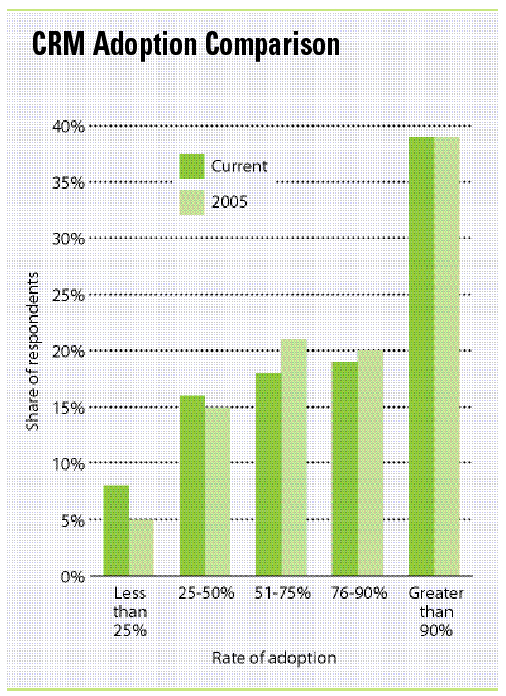Don’t Confuse Implementation with Adoption
For the rest of the May 2009 issue of CRM magazine, please click here.
The implementation of CRM systems has increased significantly from 57 percent of the firms CSO Insights surveyed in 2005 to 72 percent of the sales organizations that took part in our 2009 Sales Performance Optimization study. One could therefore conclude that technology enablement has become a mainstay of selling. An additional data point to support that assumption is that 41 percent of the firms that do not yet have a CRM system in place told us they would be evaluating or implementing one this year.
But a deeper dive into the study data shows that while the percentage of firms implementing CRM has increased, utilization of the tools within those sales forces has not. Consider the following chart that compares 2005 and 2009 end-user adoption rates of CRM, which we defined as the percentage of sales reps who use the application as part of their daily workflow.

Look at the supposedly “upper” end of the scale: Adoption rates of greater than 75 percent are essentially flat. On the lower end, adoption rates of less than 50 percent have increased overall, from 20 percent to 24 percent. (The bar graph above segments the figures in greater detail.) The real power of CRM will not be realized with this “sort-of” usage. The greater-than-90-percent rates need to become much higher. So what’s hindering them?
Anyone who’s been exposed to CRM for more than 10 years remembers the high failure rate of projects in the 1990s, and might blame the applications themselves. That may well be one factor: Among the firms we surveyed, 13 percent of those with an installed CRM solution stated that they were looking to replace that system in 2009. But we think there’s a bigger issue here.
Digging into my past columns, I came across one I wrote in 1997, where I noted that the first sale you needed to make with a CRM system was an “internal sale”: You had to make salespeople understand the benefits of integrating the use of technology into their approach to selling—how they’d be more efficient, how technology could make them more effective.
Is that happening today? Again, the study data suggests not, as 43 percent of the firms we surveyed said that their end-user training in CRM “needed improvement.” Some vendor claims aside, our benchmarking has shown that the value of CRM is not intuitive to all salespeople. And unless the CRM project team, sales training team, or sales management invests the time to show reps the personal payback they’ll receive for taking the time to learn and use CRM capabilities, the solutions will go unused (or underused) by many.
In today’s economic climate, sales organizations need to be leveraging every asset they have as effectively as possible. Since most firms already have a CRM solution in place, we need to invest time and resources to make sure reps are fully utilizing all the functions available to them—especially the capabilities that can help them make more calls and better calls—as they aim for their 2009 revenue targets.
Jim Dickie is a partner with CSO Insights, a research firm that specializes in benchmarking CRM and sales effectiveness initiatives. He can be reached at jim.dickie@csoinsights.com.
Every month, CRM magazine covers the customer relationship management industry and beyond. To subscribe, please visit http://www.destinationcrm.com/subscribe/.
Related Articles
CRM in the Palm of Your Hand
01 Jul 2009
Three factors are combining to (finally) drive interest in mobile CRM.
iCentera Enlivens Sales Enablement
19 Jun 2009
Portal software provider builds upon its sales enablement offering with version 6.0 and taps into what one analyst calls an "emerging market" in the process.